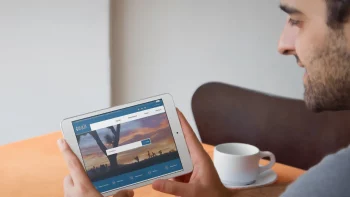Elbow bumps are replacing handshakes, and virtual yoga is replacing hot yoga—but are these temporary measures part of maintaining a flattened curve or a permanent societal shift in how we engage with one another in recreational programming and our community? As cities and counties across the nation begin to take the first, tentative steps toward reopening facilities and office doors, the pressure to keep residents safe is just as fervid, maybe even more. This pressure means that for parks and recreation leaders creating their summer and fall activity strategies, the issue may not be encouraging residents to show up, it may be enabling participants to interact with one another and public equipment, safely. In working with parks and rec experts across the country, we are observing six crucial changes to the resident engagement model for parks and rec departments in our post-pandemic society.
More Education and Constant Safety Reminders
After months of staying safer at home, many residents are hearing that their parks, trails, beaches, and pools are reopening and are adopting a false sense of security that opening facilities mean the threat of virus contagion is minimal. Parks and rec leaders must offer continual education and reminders to reinforce that all Americans must still do their part to minimize the chance of a surging virus spike.
Parks and rec department staff must keep the reality of a post-outbreak world at the forefront of visitors’ minds by posting health and safety messaging within facilities, parks, trails, and other public locations. Such messaging must encourage personal safety and implore visitors to stay home if they are experiencing symptoms or have directly encountered a COVID-19 patient. Parks and facilities are also likely to require the continued use of face masks and the practicing of socially distanced behaviors in some relevant group activities. In some of the most impacted communities, participants may even need to stop at a temperature station to validate they are not exhibiting fever symptoms before entering the premises.
Comfort and Reassurance
Before sending their children to little league practices or afterschool camps, parents will want to know that their parks and rec department is providing the sanitary measures and oversight needed to minimize contagion risk. Parks and rec leaders will need to communicate more frequently and in more detail to members, residents, visitors, instructors, coaches, and parents. Your community will want access to documentation regarding sanitization protocols, staff training, and instructor expectations so that they can rest assured that they are not putting their child at risk by signing them up for seasonal activities.
Additional Safety Measures
Parks and recreation teams have always prioritized cleanliness and sanitation, but COVID-19 has made us all hypervigilant of the need to disinfect common surfaces frequently. Activity staff must make accommodations to ensure ample time and available personnel to sanitize shared equipment in between participant use, including tumbling mats, art supplies, and free weights. Parents may also need to send children with personal equipment rather than relying on department-issued items. We expect to see summer camp coaches asking players to bring individual bats, balls, helmets, and gloves.
Sanitization will not be the sole responsibility of facility staff, however. All activity participants of all ages should be required to wash or sanitize hands before entering a facility, before leaving, and during an activity as appropriate. To enable such safety precautions, facilities will need to ensure they can provide proper sanitization stations, which comes with a price tag and the need to coordinate installation.
Limited Team and Contact Sports
We all know well how COVID-19 spreads and understand the risk of being within close physical contact with one another. The need to continue maintaining a careful distance from fellow neighbors is the reason why sports like golf and NASCAR can resume (without fans) more quickly and safely than football or basketball. For the same reasons, parents may be more comfortable signing their children up for non-contact or team sports in the first few seasons after the pandemic, and recreation departments should plan accordingly. We expect tennis, pickleball, golf, Zumba, dance, and swimming to be more popular recreation options than flag football, basketball, soccer, and wrestling in the coming months.
The Continuation of Virtual Programming
Many Americans, especially those with busy lives and limited availability, have learned during the pandemic, that they enjoy living room calisthenics, virtual guitar sessions, and at-home creative projects. These individuals—especially those who are immunocompromised and might be less comfortable engaging in on-site events—may be disappointed to see your community’s new virtual activity line-up end with the safer-at-home mandate. Expect to see a continued surge of esports participation, virtual fitness opportunities, and online, self-paced wellness programs, all of which may be new and ongoing sources of revenue for your administration.
Continual Restriction of Large Group Gatherings
It may not feel like the holidays without your town’s traditional tree lighting ceremony, but the possibility of allowing hundreds of people to gather in your town square may bring too high a risk come December. Until health officials advise that we have the virus under control, communities might have to continue restricting large group gatherings such as holiday parades, fireworks displays, and shopping events. Collaborate with your creative parks and rec staff to brainstorm ways to honor these traditions virtually and keep residents safe.
Additional Staff and Training
To bring our much-needed parks and rec activities back and do it safely, recreation departments will need to be trained, responsible, vigilant staff members in place—and more of them. New responsibilities of parks and facility staff may include coordinating handwashing and temperature-taking stations and circulating parks and beaches to encourage visitors to maintain social distance. To further mitigate virus spread, parks departments may need to restrict parking at area trails and beaches to limit the overall number of visitors to only those who live nearby. This safety practice can also help mitigate the chance of the virus spreading across neighborhoods and counties.
Conclusion
No one knows how long it will be until we are broadly protected from COVID-19, which means that parks and rec departments committed to keeping our communities active and healthy are facing their next great challenge. With proper training, internal and external education, staffing, and resources in place, we can come back together safely and begin experiencing life outside our doors in the much-needed recovery phase of the pandemic.


